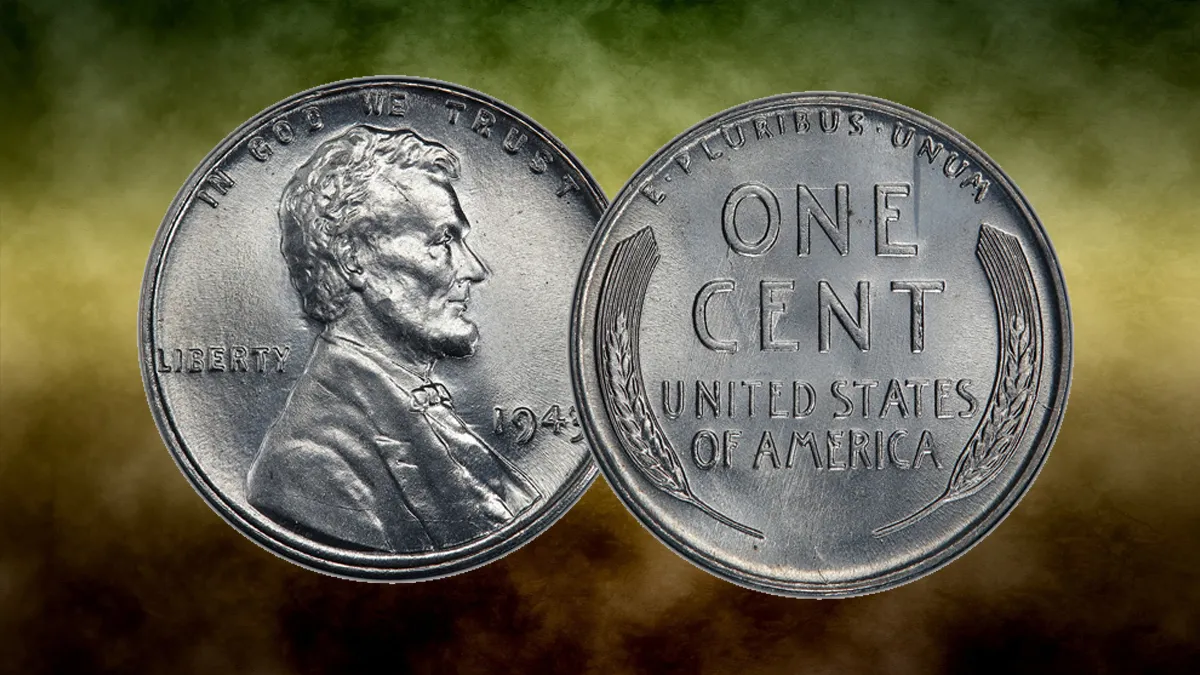
The 1943 Steel Penny is a special coin of its claim. Collectors adored this coin because it was the only year where a penny was made of steel and not of copper. The reason for the usage of steel instead of copper was war. The United States needed every piece of copper so that they could get their hands on it to make ammunition and military supplies. The 1943 Copper Penny is one of the rarest of all time.
What are Steel Pennies?
The 1943 Steel Penny is one of the most unique American coins ever minted, these pennies are Lincoln Wheat cents. This was done to conserve copper for the war effort in World War 2.
There are a few vintage coins as widely collected as the 1943 steel Lincoln penny. The 1943 steel Lincoln penny is usually famous among the collectors. This coin is unique in its appearance among US one-cent coins. The coin stands out as unique due to its zinc-coated composition, making it look more like a dime than a typical penny.
The 1943 Steel Penny was designed by Victor Brenner. The obverse side of the coin features a side photo of former president Abraham Lincoln. Whereas the reverse side of the coin features two wheat stalks surrounded by the word ‘one cent’.
The 1943 steel penny is composed of a steel core with a coating of zinc, giving it a silver color. Steel pennies often range in value from a few cents to $20.
Historical Background of the 1943 Steel Penny
In 1943, the United States was engaged in World War II. Many resources including food, fuel, and metals like copper were diverted into the war. Earlier the pennies were made of copper, but due to the war effect steel was used instead of copper for making pennies. The reason for the switching of metals was, that ammunition and electrical wires had to be crafted from copper during the war.
Thus US Mint decided to make the 1943 penny out of steel. All three US Mints: San Francisco, Philadelphia, and Denver were directed to produce steel pennies.
Determining the Authenticity of a 1943 Steel Penny
The 1943 steel penny stands out in the world of numismatics, and it is important to determine its rarity. One must distinguish between the standard issue and the largely sought-after error coin.
It is important to know the difference between a real penny and a fake one.
There are a few features that can be used to differentiate steel and copper pennies.
- A solid magnet will draw in a steel penny, but no effect will be seen on a copper one.
- Steel pennies weigh around 2.7 grams whereas copper pennies weigh 3.11 grams.
- When dropped from a certain height, steel pennies have a distinctive high-pitched “ring”, while copper coin makes a dull sound when dropped.
- Steel pennies need the normal copper sparkle, frequently having a graying blue hue.
Rarity and Condition: Key Factors in Valuing 1943 Steel Pennies
Deciding the value of the 1943 penny involves inspecting several key factors that can notably impact its worth.
The first step is to inspect the coin’s condition, as this factor plays an important role in the value. Look for signs of wear and tear like scratches, dents, or discoloration, and notice if the coin’s gloss is still present. Coins in the best condition can be significantly more profitable than those with unmistakable signs of heavy use.
The next is to pay attention to the mint marks on the steel penny. Mint Marks uncovers the particular US mint that created the coin and can offer assistance to reveal the US Mint that produced the coin and can help to create its rarity. On the 1943 steel penny, the mint mark can be found underneath the date. “D” speaks to the Denver Mint, “S” speaks to the San Francisco Mint, and, no stamp presents the Philadelphia Mint.
Moreover, it is essential to check for mint errors that may have occurred during the production of coins. Mint errors can happen when something goes wrong in the process of minting, which results in a change in the standard design.
To precisely gauge the value of the 1943 steel penny, all together look at the coin taking into account its condition, mint marks, and potential mint mistakes.
Notable Sales and Auction Records of 1943 Steel Pennies
A rare 1943 Lincoln cent was found in a teen’s high school cafeteria pocket change for $204,000 at a public auction of US coins held in Orlando, Florida by Heritage Auctions, the world’s largest coin auctioneer.
Here are a few popular disclosures and values accomplished by 1943 steel pennies as per The U.S. Sun’s reports:
- MS66 grade penny fetched $408,000 in 2021
- MS64 grade coin sold for $118,000 in 2023
- MS63 grade penny sold for $115,000 in 2007
Also Read – Top 10 Most Valuable Peace Dollars
Conclusion
In 1944, they switched back to copper pennies. But there were still some steel pennies left and somehow got mixed with the copper batch. So there are a few 1943 steel pennies worth million dollars, that are in circulation. So if you find a 1943 penny and the color looks off and attracts to the magnet, you have one.
If you are fond of rare pennies, the 1943 penny is for you. In 1943 the US faced a copper shortage due to World War II, which resulted in the production of steel pennies instead of copper. This makes the 1943 steel penny a highly desirable penny among coin collectors.
So before you disregard that ancient penny as unimportant, discover the captivating world of the 1943 penny and its potential esteem.
However, some fake people will try to convince you, saying it is an original 1943 penny. Therefore before you invest any money in purchasing rare coins, make sure they are examined and authenticated by a professional or you must deal with a trusted coin dealer.
FAQ’s
1. What is a 1943 penny worth today?
A 1943 penny is worth about 10 – 20 cents in the condition of circulation.
2. What is the rare error on the 1943 penny?
A rare error on the 1943 penny is the presence of copper coating.
3. How much does a 1943 penny weigh?
A 1943 silver penny weighs about 2.8 grams.
4. Why was there a shift from copper to silver penny production in 1943?
The United States was faced with the effects of World War II, where copper was to be used in arms and ammunition, which resulted in a shift from copper penny to silver penny.
